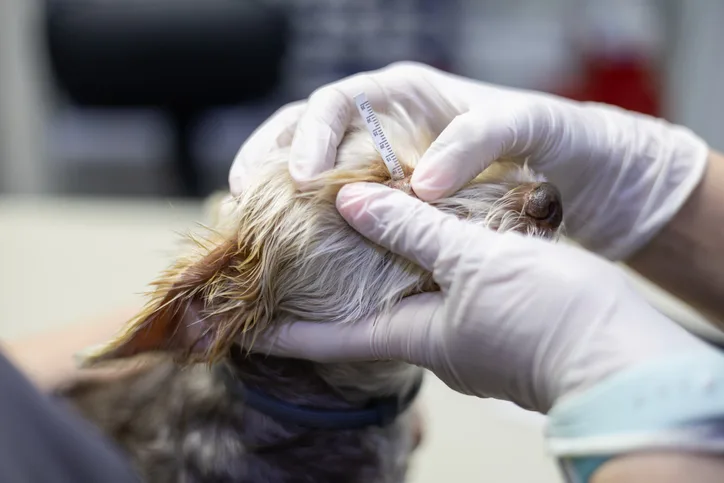
In the Literature
Pe'er O, Ofri R, Sebbag L. Schirmer tear test‐1 with open or closed eyelids: an evaluation in brachycephalic and nonbrachycephalic dogs. Vet Ophthalmol. 2024. doi:10.1111/vop.13222
The Research …
Schirmer tear test 1 (STT-1) is the standard test for keratoconjunctivitis sicca (ie, dry eye) in dogs. Many factors (eg, time of day, ambient humidity, strip manufacturer, medications, patient factors) can affect STT-1 values; whether manually closing the eyelids can affect results has been unknown.
In this study, healthy brachycephalic (shih tzus; n = 15) and nonbrachycephalic (Labrador retrievers; n = 15) dogs underwent STT-1 with the eyelids held closed or normal blinking allowed during the test. Both test conditions were applied to all dogs in a randomized manner, and measurements were taken at 10-second intervals for 1 minute. In addition, members of the veterinary ophthalmology community were surveyed regarding how they routinely perform STT-1 in dogs (ie, eyelids closed or open or unknown).
STT-1 values were significantly higher in dogs with manually closed eyelids compared with dogs with open eyelids at all time points (brachycephalic, 18.6 ± 2.7 mm/minute closed vs 16.3 ± 2.5 mm/minute open; nonbrachycephalic, 21.6 ± 2.9 mm/minute closed vs 17.8 ± 3.2 mm/minute open). This pattern has also been observed in horses,1 but the effect appears more clinically significant in dogs. STT-1 values were significantly higher in nonbrachycephalic dogs compared with brachycephalic dogs at all time points with closed eyelids and at the 10- and 20-second time points with open eyelids. Previous evidence supports that brachycephalic dogs have lower levels of aqueous tear secretion.2 STT-1 strips prematurely dislodged from the conjunctival fornix in 6 dogs with open eyelids and no dogs with closed eyelids.
Of 275 members of the veterinary ophthalmology community who responded to the survey, 38.5% reported they perform STT-1 with the eyelids manually closed, and 26.9% reported they perform the test with the eyelids open. The remaining respondents (34.6%) indicated they do not consciously notice eyelid position during testing.
The study authors suggest an open or closed eyelid technique is appropriate for STT-1 in dogs but recommend consistent use of one technique during monitoring, as eyelid position can cause clinically meaningful alterations in STT-1 values. Inclusion of only 2 dog breeds and healthy dogs without eye disease were limitations of the study; findings may be different in other breeds or dogs with eye disease.
… The Takeaways
Key pearls to put into practice:
Manual closure of the eyelids during STT-1 in dogs resulted in higher values.
A higher number of STT-1 strips were dislodged prematurely when the eyelids were open.
Of surveyed veterinarians, 38.5% reported manually closing the eyelids when performing STT-1 in dogs.
Aqueous tear production varies by breed and is lower in brachycephalic dogs.
Either an open or closed eyelid technique is appropriate for STT-1 if consistency is maintained during serial monitoring.
You are reading 2-Minute Takeaways, a research summary resource presented by Clinician’s Brief. Clinician’s Brief does not conduct primary research.